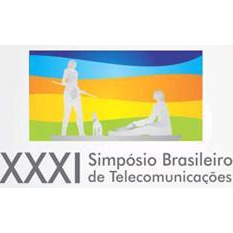
XXXI Simpósio Brasileiro de Telecomunicações
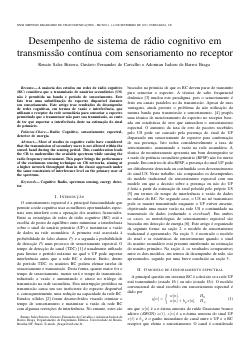
Desempenho de sistema de rádio cognitivo em transmissão contínua com sensoriamento no receptor
Renato Sales Bizerra, Gustavo Fernandes de Carvalho, Adoniran Judson de Barros Braga
DOI: 10.14209/sbrt.2013.101
Keywords: Cognitive Radio spectrum sensing energy detector
Abstract
Most of studies in cognitive radio have considered that the transmission of secondary users is not allowed within the sensed band during the sensing period. This consideration leads the CR to under utilize the available spectrum while sensing the radio frequency environment. This paper brings the performance of the continuous sensing technique on CR networks, aiming at a higher network throughput than in the classic approach under the same constraints of interference level on the primary user of the spectrum.Download
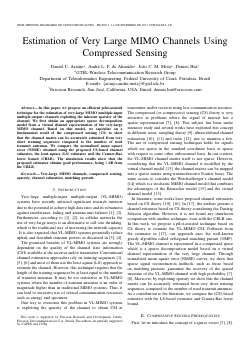
Estimation of Very Large MIMO Channels Using Compressed Sensing
Daniel C. Araújo, André L. F. de Almeida⋆, João C. M. Mota, Dennis Hui†
DOI: 10.14209/sbrt.2013.95
Keywords: Very-large MIMO channels compressed sensing sparsity channel estimation matching pursuit.
Abstract
In this paper, we propose an efficient pilot-assisted technique for the estimation of very-large MIMO (multiple-input multiple-output) channels exploiting the inherent sparsity of the channel. We first obtain an appropriate sparse decomposition model from a virtual channel representation of the very-large MIMO channel. Based on this model, we capitalize on a fundamental result of the compressed sensing (CS) to show that the channel matrix can be accurately estimated from very short training sequences compared to the number of used transmit antennas. We compare the normalized mean square error (NMSE) obtained using the proposed CS-based channel estimator, the least-square (LS) estimator and the Cramer-Rao lower bound (CRLB). The simulation results show that the proposed estimator obtains good performance, being 5 dB from the CRLB.Download
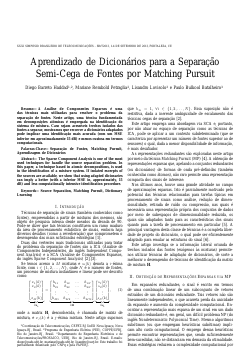
Aprendizado de Dicionários para a Separação Semi-Cega de Fontes por Matching Pursuit
Diego Barreto Haddad, Mariane Rembold Petraglia, Lisandro Lovisolo, Paulo Bulkool Batalheiro
DOI: 10.14209/sbrt.2013.96
Keywords: Source Separation Matching Pursuit Dictionary Learning
Abstract
The Sparse Component Analysis is one of the most used techniques for handle the source separation problem. In this paper, a technique based in atomic decompositions, is used in the identification of a mixture system. If isolated excerpts of the sources are available, we show that using adapted dicionaries can imply a better (with a inferior MSE in, approximately, 15 dB) and less computationally intensive identification procedure.Download
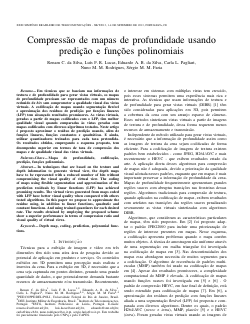
Compressão de mapas de profundidade usando predição e funções polinomiais
Renam C. da Silva, Luís F. R. Lucas, Eduardo A. B. da Silva, Carla L. Pagliari, Nuno M. M. Rodrigues, Sérgio M. M. Faria
DOI: 10.14209/sbrt.2013.102
Keywords:
Abstract
In techniques that are based on the texture and depth information to generate virtual view, the depth maps have to be represented with a reduced number of bits without compromising the visual quality of virtual view. The coding of maps using flexible segmentation and approximation of the prediction residuals by linear functions (LFP) has achieved promising results. The virtual views generated from maps coded with LFP have better visual quality when compared with others tested algorithms. In this paper we propose to approximate the residue using, in addition to linear functions, quadratic and constant functions. And using trained quantizers for each desired rate. The results obtained by employing the proposed scheme show a superior performance in terms of compression ratio and visual quality of virtual views.Download
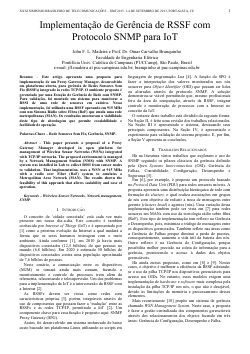
Implementação de Gerência de RSSF com Protocolo SNMP para IoT
John F. L. Madeira, Prof. Dr. Omar Carvalho Branquinho
DOI: 10.14209/sbrt.2013.34
Keywords: Rede Sensores Sem Fio Gerência SNMP
Abstract
Este artigo apresenta uma proposta para implementação de um Proxy Gateway Manager, desenvolvido em plataforma aberta, para gerência de Redes Sensores Sem Fio (RSSFs) integrado ás redes TCP/IP. O ambiente proposto é gerenciado por uma Estação de Gerência de Rede com SNMP. Para validação, foi montado um sistema para monitorar a RSSI de uma rede de sensores em cadeira. Nessa implementação, foi utilizada uma RSSF operando em 915 MHz com um Sistema Rádio sobre Fibra (RoF) que emula uma rede metropolitanas (MAN). Os resultados mostraram a viabilidade deste tipo de abordagem que permite escalabilidade e facilidade de operaçãoDownload

Evaluation of Image Color Metrics for Watermarked Color Images
André Rodrigues, Fabiana Fernandes, Zélia Peixoto, Flávia Freitas
DOI: 10.14209/sbrt.2013.103
Keywords: Image Quality Color Images Color Difference Digital Watermark Evaluation of Imperceptibility PSNR MPSNR MSSIM ΔEab ΔE00
Abstract
This paper presents a comparative study of performance metrics applied to color images with invisible digital watermark. The imperceptibility of the watermark and the distortion that can cause in the image are important factors in the evaluation of the invisible watermark insertion algorithms and usually this is done through the performance metrics. Thus, the aim of this article is to analyze and evaluate the results obtained through different performance metrics. The metrics chosen through literature were: PSNR, MPSNR, MSSIM, ΔEab and ΔE00.Download

Obtenção dos parâmetros primários de cabos de cobre para o padrão G.fast com os softwares CST e OptEM
D.L.L. Silva, W.B. Monteiro, J.C.W.A. Costa
DOI: 10.14209/sbrt.2013.104
Keywords: Simulação numérica Parâmetros primários Cabos de cobre
Abstract
Este artigo apresenta simulações de parâmetros primários para cabos de cobre em frequências até 100 MHz. Especificamente, dois simuladores numéricos – CST Cable Studio 2012 e OptEM – foram comparados com um modelo de cabo analítico. Os resultados indicam que o CST Cable Studio 2012 não reproduz o efeito de proximidade. O OptEM, sendo um simulador específico para indústria de cabos, apresenta resultados mais próximos da teoria, para os casos considerados.Download
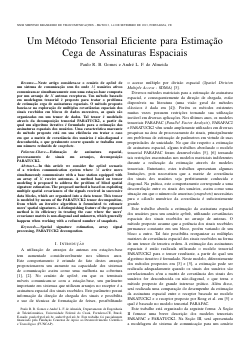
Um Método Tensorial Eficiente para Estimação Cega de Assinaturas Espaciais
Paulo R. B. Gomes, André L. F. de Almeida
DOI: 10.14209/sbrt.2013.105
Keywords: Spatial signature estimation,array signal processing PARATUCK2 decompostion
Abstract
In this article we consider the uplink scenario of a wireless communication system where M active users simultaneously communicate with a base station equipped with an array of K receive antennas. A method based on tensor modeling is proposed to address the problem of blind spatialsignature estimation. The proposed method is based on exploiting multiple spatial covariances of the signals received in successive data blocks, which are organized into a data tensor. This tensor is modeled by means of the PARATUCK2 tensor decomposition, from which an iterative algorithm is formulated to estimate users’ spatial signatures. A distinguishing feature of the proposed method is its efficiency in treating the case where the users’ covariance matrix is non-diagonal and unknown, which generally happens when working with a reduced number of snapshots.Download

Avaliação da Modulação 4D-8PSK TCM em Canal Não Linear
Luciano B. C. Silva, Marcelo S. Pinho
DOI: 10.14209/sbrt.2013.106
Keywords: Comunicação Digital Comunicação por Satélite Modulação Codificada em Treliça Canal Não Linear
Abstract
O desempenho da modulação codificada em treliça multidimensional 4D-8PSK TCM em canal não linear é analisado por simulação, utilizando um amplificador à válvula de ondas progressivas (TWTA) comercial para o modelamento das distorções AM/AM e AM/PM. Os resultados são avaliados por meio de comparações com outras modulações, enfatizando o impacto na taxa de erro de bit (BER) e no fenômeno conhecido como Spectral Regrowth. Observa-se um aumento da margem do enlace em torno de 3 dB em relação às modulações antipodais, para canal linear, e uma degradação de 0,25 dB devido às distorções não lineares, considerando uma BER de 10-5.Download
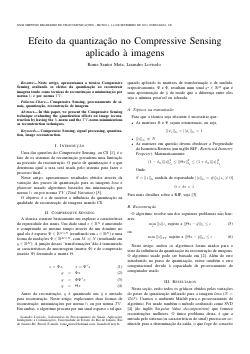
Efeito da quantização no Compressive Sensing aplicado à imagens
Ronie Santos Mota, Lisandro Lovisolo
DOI: 10.14209/sbrt.2013.107
Keywords: Compressive Sensing signal processing quantization image reconstruction
Abstract
In this paper, we present the Compressive Sensing technique evaluating the quantization effects on image reconstruction by having the L1-norm and the TV-norm minimizations as reconstruction techniques.Download